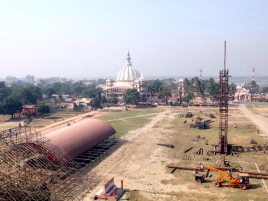Valentine Inauguration for New Mayapur Temple
By Madhava Smullen | Фев 14, 2010

On Valentine’s Day this year—February 14th 2010—a labor of love that doesn’t involve flowers, chocolates or expensive dates is finally coming into fruition.
After thirty years in development, ISKCON’s Temple of the Vedic Planetarium will be inaugurated this weekend in a 10:00am historic ceremony as part of the annual Gaura Purnima ceremony in Mayapur, India.
The program will include a Vedic fire sacrifice to invoke auspiciousness for the successful completion of the temple, while four large copper plates, with various Vedic signs carved on them, will be laid at the four corners of the temple construction site. The ceremony will be presided over by one of India’s most well-known Vastu shastra consultants.
As construction teams clear the grounds in preparation for the ceremony, devotees in ISKCON’s international headquarters in Mayapur—as well as around the world—are feeling a thrill of excitement. Originally conceived by ISKCON founder Srila Prabhupada in the 1970s, the Temple of the Vedic Planetarium has long been the society’s Holy Grail. Yet now, it is on the verge of becoming a reality.
The finished temple will be thirty storeys high and will house several altars: one for the Gaudiya Vaishnava line of teachers and disciples, ranging from the Six Goswamis of the 15th century all the way to Srila Prabhupada; one for the Pancha-tattva of Shri Chaitanya Mahaprabhu and his associates; one for Sri-Sri Radha-Madhava and their eight principal gopi servants; and one for Krishna’s half-man half lion form, Lord Nrsimhadeva.
It will of course also include the eponymous planetarium, which will offer a stunning tour of the cosmic creation as described by sacred texts such as the Srimad-Bhagavatam.
Managers of the project expect the deities to be installed and the temple to become fully functional six years from now, with more detail work expected to continue on for a further decade.















